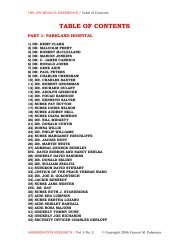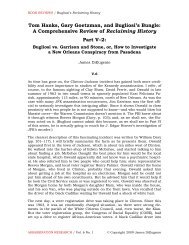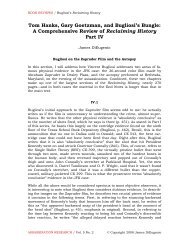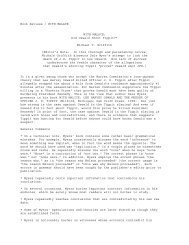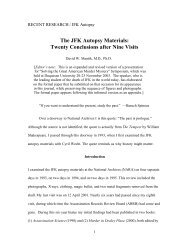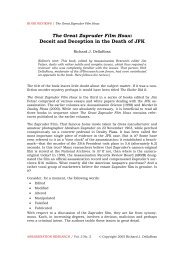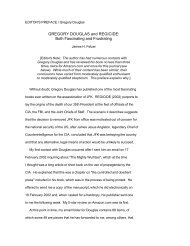Reclaiming History: A Closed Mind Perpetrating a Fraud on the Public
Reclaiming History: A Closed Mind Perpetrating a Fraud on the Public
Reclaiming History: A Closed Mind Perpetrating a Fraud on the Public
Create successful ePaper yourself
Turn your PDF publications into a flip-book with our unique Google optimized e-Paper software.
BOOK REVIEWS / Bugliosi’s <str<strong>on</strong>g>Reclaiming</str<strong>on</strong>g> <str<strong>on</strong>g>History</str<strong>on</strong>g><br />
<str<strong>on</strong>g>Reclaiming</str<strong>on</strong>g> <str<strong>on</strong>g>History</str<strong>on</strong>g>:<br />
A <str<strong>on</strong>g>Closed</str<strong>on</strong>g> <str<strong>on</strong>g>Mind</str<strong>on</strong>g> <str<strong>on</strong>g>Perpetrating</str<strong>on</strong>g> a <str<strong>on</strong>g>Fraud</str<strong>on</strong>g> <strong>on</strong> <strong>the</strong> <strong>Public</strong><br />
James H. Fetzer, Ph.D.<br />
5 June 2007<br />
Am<strong>on</strong>g all <strong>the</strong> books ever published <strong>on</strong> <strong>the</strong> death of JFK, Vincent Bugliosi’s <str<strong>on</strong>g>Reclaiming</str<strong>on</strong>g><br />
<str<strong>on</strong>g>History</str<strong>on</strong>g>: The Assassinati<strong>on</strong> of President John F. Kennedy (2007) effortlessly<br />
qualifies as <strong>the</strong> most audacious. Spanning more than 1600 pages in<br />
length (with yet ano<strong>the</strong>r 1000 pages of notes <strong>on</strong> an accompanying CD), its author<br />
claims <strong>the</strong> moral high-ground, c<strong>on</strong>tending that he, unlike <strong>the</strong> majority of<br />
c<strong>on</strong>spiracy authors, would never mislead his readers by lies, omissi<strong>on</strong>s, and deliberately<br />
distorting <strong>the</strong> official record (p. xv). If <strong>the</strong>y are c<strong>on</strong>fr<strong>on</strong>ted with evidence<br />
that is incompatible with <strong>the</strong>ir fanciful <strong>the</strong>ories, <strong>the</strong>y, but not he, ei<strong>the</strong>r<br />
twist, warp, and distort <strong>the</strong> evidence, or simply ignore it, both of which are designed<br />
to deceive <strong>the</strong>ir readers (p. xiv). That is what he tells us.<br />
He also tells us that The Warren Report (1964), The HSCA Final Report (1979)—<br />
apart from mistakenly adding a sec<strong>on</strong>d shooter from <strong>the</strong> grassy knoll—and even<br />
Gerald Posner’s Case <str<strong>on</strong>g>Closed</str<strong>on</strong>g> (1993), which he faults for sloppy research, got it<br />
right: a l<strong>on</strong>e assassin fired three shots from <strong>the</strong> 6th floor of <strong>the</strong> Texas School<br />
Book Depository, scoring two hits and <strong>on</strong>e miss. One shot (<strong>the</strong> “magic bullet”)<br />
entered <strong>the</strong> base of <strong>the</strong> back of <strong>the</strong> neck—interestingly, Bugliosi describes it as<br />
“<strong>the</strong> upper right part of his back”—traversing it without hitting any b<strong>on</strong>y structures,<br />
exiting just above <strong>the</strong> tie to enter John C<strong>on</strong>nally’s back, shatter a rib, exit<br />
and collide with his right-wrist before entering his left thigh. A sec<strong>on</strong>d shot hit<br />
him in <strong>the</strong> head and killed him. Oh, yes! He also tells us his name was Lee<br />
Harvey Oswald.<br />
Bugliosi lays all of this out in <strong>the</strong> very first paragraph of his book, except for <strong>the</strong><br />
identity of <strong>the</strong> assassin, which he attempts substantiate in <strong>the</strong> rest of his book!<br />
This may not seem like much to report after having devoted 21 years to <strong>the</strong> investigati<strong>on</strong><br />
of this case, but that is what he tells us. If <strong>the</strong>re were no l<strong>on</strong>e assassin,<br />
however, if <strong>the</strong>re were more than three shots or if <strong>the</strong> “magic bullet” <strong>the</strong>ory<br />
were untrue, <strong>the</strong>n (all sides agree) <strong>the</strong>re would have to have been more than <strong>on</strong>e<br />
shooter and, <strong>the</strong>refore, a JFK c<strong>on</strong>spiracy. Indeed, even Michael Baden, M.D.,<br />
who chaired <strong>the</strong> Medical Panel for <strong>the</strong> HSCA during its reinvestigati<strong>on</strong> in 1977–<br />
78, has observed that, if <strong>the</strong> “magic bullet” <strong>the</strong>ory were false, <strong>the</strong>n <strong>the</strong>re must<br />
have been at least six shots from three directi<strong>on</strong>s! Yet, it is not difficult to dem<strong>on</strong>strate<br />
that <strong>the</strong> “magic bullet” <strong>the</strong>ory is false.<br />
So how seriously should we take this book? Not very. Having organized a research<br />
group c<strong>on</strong>sisting of <strong>the</strong> best qualified pers<strong>on</strong>s to ever investigate <strong>the</strong><br />
case, having chaired or co-chaired four nati<strong>on</strong>al c<strong>on</strong>ferences, published three<br />
books (comprising nearly 1500 pages in length), and founded an electr<strong>on</strong>ic<br />
journal for advanced study of <strong>the</strong> death of JFK, it is obvious to me that Bugliosi<br />
has misled his readers by lies, omissi<strong>on</strong>s, and deliberate distorti<strong>on</strong>s, where, in<br />
particular, when c<strong>on</strong>fr<strong>on</strong>ted with evidence that is incompatible with his own—<br />
ASSASSINATION RESEARCH / Vol. 5 No. 1 © Copyright 2007 James H. Fetzer
James H. Fetzer 2 Bugliosi’s <str<strong>on</strong>g>Reclaiming</str<strong>on</strong>g> <str<strong>on</strong>g>History</str<strong>on</strong>g><br />
official but fanciful—<strong>the</strong>ory, he ei<strong>the</strong>r twists, warps, and distorts <strong>the</strong> evidence or<br />
simply ignores it. His key claims are not merely provably false but, in crucial<br />
cases, not even physically possible. How can this be <strong>the</strong> case?<br />
Science vs. <strong>the</strong> Law<br />
Vincent Bugliosi is a brilliant prosecutor. His success in <strong>the</strong> courtroom has resulted<br />
from his remarkable capacity to persuade o<strong>the</strong>rs that what he tells <strong>the</strong>m<br />
is true. The capacity to persuade o<strong>the</strong>rs that what you have to say is true, however,<br />
is not <strong>the</strong> same thing as telling <strong>the</strong> truth. Truth is a property of sentences<br />
in a language (including ma<strong>the</strong>matical statements in <strong>the</strong> natural sciences),<br />
where a sentence in that language is true when it corresp<strong>on</strong>ds with <strong>the</strong> way<br />
things are (what <strong>the</strong>re is or what is <strong>the</strong> case). When what you are being told corresp<strong>on</strong>ds<br />
to <strong>the</strong> way things are (what <strong>the</strong>re is, what is <strong>the</strong> case), <strong>the</strong>n you are<br />
being told <strong>the</strong> truth. O<strong>the</strong>rwise, you are not. But you may or may not be wellpositi<strong>on</strong>ed<br />
to tell <strong>the</strong> difference. And <strong>the</strong>rein lies <strong>the</strong> rub!<br />
The difference between Socrates and <strong>the</strong> Sophists was that Socrates used his<br />
ability to reas<strong>on</strong> for <strong>the</strong> purpose of discovering truth, while <strong>the</strong> Sophists used<br />
<strong>the</strong>ir abilities for <strong>the</strong> purpose of persuasi<strong>on</strong>. Am<strong>on</strong>g those who represent <strong>the</strong><br />
Sophistic traditi<strong>on</strong> today are used-car salesmen, politicians, and lawyers. In <strong>the</strong><br />
American adversarial traditi<strong>on</strong>, during criminal proceedings, such as <strong>the</strong> c<strong>on</strong>duct<br />
of a trial, <strong>the</strong> defense attorneys have <strong>the</strong> duty to provide <strong>the</strong>ir clients with<br />
a zealous defense, which means presenting just <strong>the</strong> evidence that tends to exculpate<br />
<strong>the</strong>m from <strong>the</strong> crime alleged. The prosecutor bears <strong>the</strong> greater burden<br />
of c<strong>on</strong>sidering evidence <strong>on</strong> both sides to insure that justice is d<strong>on</strong>e. Bugliosi’s<br />
zeal to c<strong>on</strong>vict Oswald has overcome his commitment to justice.<br />
How is this possible? After <strong>the</strong> publicati<strong>on</strong> of Assassinati<strong>on</strong> Science (1998), with<br />
eleven expert c<strong>on</strong>tributors, and of Murder in Dealey Plaza (2000), with nine,<br />
which we sent to Bugliosi, David W. Mantik, M.D., Ph.D., with whom I had been<br />
collaborating for nearly a decade, suggested that I write to him and ask, “What<br />
would it take to c<strong>on</strong>vince you of a c<strong>on</strong>spiracy and cover-up in <strong>the</strong> death of JFK?<br />
Are n<strong>on</strong>e of our major discoveries—our 16 smoking guns, for example [published<br />
<strong>on</strong> pp. 1–14 of Murder]—c<strong>on</strong>vincing? And, if not, why? And, if not, what<br />
would it take? (23 January 2001).” His answer was simple: “Only evidence, Drs.<br />
Fetzer and Mantik. Only evidence.” Yet it is ra<strong>the</strong>r easy to prove he ignores our<br />
evidence, violating his own standards.<br />
Bugliosi is not an historian or a scientist. While he accepts <strong>the</strong> books I have edited<br />
as <strong>the</strong> <strong>on</strong>ly exclusively scientific books (three) <strong>on</strong> <strong>the</strong> assassinati<strong>on</strong> (p. 974),<br />
<strong>the</strong>re can be no room for doubt that he has ignored <strong>the</strong>m. My guess is that, as<br />
Mantik suggests (Review in this issue of Assassinati<strong>on</strong> Research), Bugliosi<br />
commits a blunder in epistemology, c<strong>on</strong>founding a jurisprudential model (as<br />
some have called it) with a scientific model of investigati<strong>on</strong>. Courtroom procedures<br />
are useful to resolve c<strong>on</strong>flicts in limited intervals of time using available<br />
evidence based up<strong>on</strong> degrees of subjective credibility, while scientific procedures<br />
are intended to establish truths over unlimited intervals of time <strong>on</strong> <strong>the</strong><br />
basis of objective measures of evidential support.<br />
ASSASSINATION RESEARCH / Vol. 5 No. 1 © Copyright 2007 James H. Fetzer
James H. Fetzer 3 Bugliosi’s <str<strong>on</strong>g>Reclaiming</str<strong>on</strong>g> <str<strong>on</strong>g>History</str<strong>on</strong>g><br />
The One Minute Proof<br />
The differences are several. Practical decisi<strong>on</strong>-making requires resoluti<strong>on</strong>s in a<br />
finite interval using <strong>the</strong>n-available evidence that is both relevant and admissible.<br />
These decisi<strong>on</strong>s are typically definitive and afford a means for settling c<strong>on</strong>flicts.<br />
Scientific knowledge-acquisiti<strong>on</strong>, by c<strong>on</strong>trast, does not end after a finite<br />
interval but, with <strong>the</strong> accumulati<strong>on</strong> of new evidence, can lead to <strong>the</strong> rejecti<strong>on</strong> of<br />
hypo<strong>the</strong>ses previously accepted, <strong>the</strong> acceptance of hypo<strong>the</strong>ses previously rejected,<br />
and <strong>the</strong> suspensi<strong>on</strong> of belief in cases that were previously assumed settled.<br />
The successi<strong>on</strong> of classical mechanics over Aristotelian physics and its<br />
subsequent defeat by relativity <strong>the</strong>ory are striking examples having parallels in<br />
chemistry, biology, and psychology.<br />
In an earlier book, The Betrayal of America (2001) <strong>on</strong> <strong>the</strong> Supreme Courts decisi<strong>on</strong><br />
in <strong>the</strong> 2000 electi<strong>on</strong>, Bugliosi introduces an argument about (what he<br />
takes to be) a blunder keeping most o<strong>the</strong>rwise intelligent citizens from thinking<br />
intelligently about JFK, elaborating a <strong>on</strong>e minute proof he had advanced to a<br />
group of 600 trial lawyers. He first asked if <strong>the</strong>y had read criticism of The Warren<br />
Report (1964) or seen <strong>the</strong> film, JFK. Many hands rose. He was sure <strong>the</strong>y<br />
would agree that, before making up <strong>the</strong>ir minds, <strong>the</strong>y should hear both sides.<br />
With that in mind, he asked, “How many have read The Warren Report?” Very<br />
few raised <strong>the</strong>ir hands. Most members of this audience had rejected <strong>the</strong> Commissi<strong>on</strong>’s<br />
findings without reading its Report.<br />
But, as I pointed out in an amaz<strong>on</strong>.com review (29 May 2001), Bugliosi’s argument<br />
founders <strong>on</strong> a subtle fallacy. Suppose you were asked for your opini<strong>on</strong><br />
about astrology. Would it be a mistake <strong>on</strong> your part if you had arrived at your<br />
c<strong>on</strong>clusi<strong>on</strong> without having read books by astrologers and hearing both sides?<br />
Suppose you heard that a political leader advocated a program of Aryan supremacy,<br />
Jewish eradicati<strong>on</strong> and territorial aggressi<strong>on</strong>? Would it be a mistake<br />
<strong>on</strong> your part if you had c<strong>on</strong>cluded that those views were corrupt and unworthy<br />
without actually bo<strong>the</strong>ring to read Mein Kampf (1925–26)? Arguments that are<br />
logically sufficient to disprove its <strong>the</strong>mes offer an alternative to having to read a<br />
book that defends <strong>the</strong>m. But <strong>the</strong>y have to be grounded in good reas<strong>on</strong>s and not<br />
merely psychological appeal.<br />
The situati<strong>on</strong> with The Warren Report (1964) is highly comparable. Thus, if its<br />
principal c<strong>on</strong>clusi<strong>on</strong>s, which Bugliosi embraces, are sorted out as a set of four<br />
hypo<strong>the</strong>ses, (h1) to (h4)—including (h1) that <strong>the</strong> “magic bullet” <strong>the</strong>ory is true,<br />
(h2) that <strong>the</strong> assassin was situated above and behind his target, (h3) that he<br />
used a 6.5 mm Mannlicher–Carcano to hit his target, and (h4) that Lee Harvey<br />
Oswald was <strong>the</strong> shooter—which can be proven false <strong>on</strong> independent grounds,<br />
<strong>the</strong>n <strong>the</strong>re is surely no obligati<strong>on</strong> to read those flawed studies that “support”<br />
<strong>the</strong>m. While he claims to have 53 items of evidence incriminating Oswald, he<br />
also dismisses indicati<strong>on</strong>s that most if not all of <strong>the</strong>m appear to be planted,<br />
faked or fabricated. In his enthusiasm to c<strong>on</strong>vince his readers of Oswald’s guilt,<br />
Bugliosi adopted an uncharacteristically uncritical attitude toward “evidence”<br />
he found useful. If <strong>the</strong> “magic bullet” <strong>the</strong>ory cannot be true, if <strong>the</strong> weap<strong>on</strong> cannot<br />
have fired <strong>the</strong> bullets, and if <strong>the</strong> alleged assassin was not even at <strong>the</strong> window,<br />
<strong>the</strong> case begins to look very different, indeed.<br />
ASSASSINATION RESEARCH / Vol. 5 No. 1 © Copyright 2007 James H. Fetzer
James H. Fetzer 4 Bugliosi’s <str<strong>on</strong>g>Reclaiming</str<strong>on</strong>g> <str<strong>on</strong>g>History</str<strong>on</strong>g><br />
The “Magic Bullet” Theory<br />
The “magic bullet” requires an entry locati<strong>on</strong> at <strong>the</strong> base of <strong>the</strong> back of <strong>the</strong><br />
neck, which, as I have noted above, Bugliosi describes as “<strong>the</strong> upper right part<br />
of his back” (p. xi). No matter. We have so much evidence about this wound<br />
that, if we d<strong>on</strong>’t know where JFK was hit in <strong>the</strong> back from behind, <strong>the</strong>n we<br />
probably d<strong>on</strong>’t know anything about <strong>the</strong> case at all. C<strong>on</strong>sider that <strong>the</strong> jacket he<br />
was wearing has a hole at about 5½ inches below <strong>the</strong> collar and <strong>the</strong> shirt<br />
slightly below that. The autopsy diagram prepared by Navy Lt. Commander<br />
J. Thornt<strong>on</strong> Boswell, USNMC, shows a wound <strong>on</strong> <strong>the</strong> back at <strong>the</strong> same approximate<br />
locati<strong>on</strong>. Ano<strong>the</strong>r autopsy diagram by FBI Special Agent James W.<br />
Sibert shows <strong>the</strong> wound to <strong>the</strong> back below <strong>the</strong> wound to <strong>the</strong> throat. The holes in<br />
<strong>the</strong> shirt and jacket align with <strong>the</strong> two autopsy diagrams.<br />
Sibert and Francis X. ONeill subsequently submitted an FBI report of <strong>the</strong>ir autopsy<br />
observati<strong>on</strong>s, which included, in part, “Medical examinati<strong>on</strong> of <strong>the</strong> Presidents<br />
body revealed that <strong>on</strong>e of <strong>the</strong> bullets had entered just below his shoulder<br />
to <strong>the</strong> right of <strong>the</strong> spinal column at an angle of 45 to 60 degrees downward, that<br />
<strong>the</strong>re was no point of exit, and that <strong>the</strong> bullet was not in <strong>the</strong> body.” Moreover,<br />
<strong>the</strong> President’s pers<strong>on</strong>al physician, Admiral George G. Burkley, USNMC, in <strong>the</strong><br />
death certificate he executed <strong>on</strong> JFK, described a massive wound to <strong>the</strong> head,<br />
while adding “a sec<strong>on</strong>d wound occurred in <strong>the</strong> posterior back at about <strong>the</strong> level<br />
of <strong>the</strong> third thoracic vertebra”. Which is a locati<strong>on</strong> that corresp<strong>on</strong>ds to <strong>the</strong> same<br />
place as <strong>the</strong> o<strong>the</strong>r evidence indicates.<br />
Re-enactment photographs include stand-ins for <strong>the</strong> President with circular<br />
patches for <strong>the</strong> wounds he is supposed to have sustained, a small <strong>on</strong>e at <strong>the</strong><br />
vicinity of <strong>the</strong> occipital protuberance and a large <strong>on</strong>e about 5½ inches below <strong>the</strong><br />
collar to <strong>the</strong> right of <strong>the</strong> spinal column. Documents that were released by <strong>the</strong><br />
Assassinati<strong>on</strong> Records Review Board have shown that Rep. Gerald Ford (R–<br />
Michigan), <strong>the</strong>n a junior member of <strong>the</strong> Warren Commissi<strong>on</strong>, had <strong>the</strong> locati<strong>on</strong> of<br />
<strong>the</strong> wound re-described as entering at “<strong>the</strong> back of <strong>the</strong> neck” ra<strong>the</strong>r than in <strong>the</strong><br />
uppermost back, <strong>the</strong> exaggerati<strong>on</strong> that Bugliosi adopts. The mortician, Thomas<br />
Evan Robins<strong>on</strong>, c<strong>on</strong>firmed that <strong>the</strong>re was a wound in <strong>the</strong> back five to six inches<br />
below <strong>the</strong> shoulder and to <strong>the</strong> right of <strong>the</strong> spinal column. And Mantik has c<strong>on</strong>ducted<br />
an experiment with a CAT scan from a patient with chest and neck dimensi<strong>on</strong>s<br />
similar to those of JFK that dem<strong>on</strong>strates <strong>the</strong> official trajectory is not<br />
even anatomically possible, because cervical vertebrae intervene. The official<br />
account cannot be true.<br />
The demise of <strong>the</strong> “magic bullet” <strong>the</strong>ory means that <strong>the</strong> wound to <strong>the</strong> throat and<br />
<strong>the</strong> wounds to C<strong>on</strong>nally have to be accounted for <strong>on</strong> <strong>the</strong> basis of o<strong>the</strong>r shots<br />
and o<strong>the</strong>r shooters. Indeed, Mantik has dem<strong>on</strong>strated that, given <strong>the</strong> wound to<br />
<strong>the</strong> back and <strong>the</strong> wound to <strong>the</strong> throat combined with two wounds to <strong>the</strong> head<br />
(<strong>on</strong>e from behind and <strong>on</strong>e from in fr<strong>on</strong>t), JFK was hit at least four times. Since<br />
C<strong>on</strong>nally was hit at least <strong>on</strong>ce from <strong>the</strong> side and <strong>on</strong>e shot missed and injured<br />
James Tague, Baden is right: <strong>the</strong> “magic bullet” <strong>the</strong>ory is false and <strong>the</strong>re have to<br />
have been at least six shots from three directi<strong>on</strong>s! Which means that The<br />
Warrren Report, The HSCA Final Report, Posner’s Case <str<strong>on</strong>g>Closed</str<strong>on</strong>g>, and Bugliosi’s<br />
own <str<strong>on</strong>g>Reclaiming</str<strong>on</strong>g> <str<strong>on</strong>g>History</str<strong>on</strong>g> cannot be sustained!<br />
ASSASSINATION RESEARCH / Vol. 5 No. 1 © Copyright 2007 James H. Fetzer
James H. Fetzer 5 Bugliosi’s <str<strong>on</strong>g>Reclaiming</str<strong>on</strong>g> <str<strong>on</strong>g>History</str<strong>on</strong>g><br />
The Locati<strong>on</strong> and <strong>the</strong> Carbine<br />
C<strong>on</strong>sider hypo<strong>the</strong>sis (h2), <strong>the</strong> hypo<strong>the</strong>sis that <strong>the</strong> assassin was above and behind<br />
<strong>on</strong> <strong>the</strong> sixth floor of <strong>the</strong> Texas School Book Depository. As Stewart<br />
Galanor, Cover Up (1998), has observed, if you juxtapose <strong>the</strong> diagrams of <strong>the</strong><br />
wounds that JFK is supposed to have sustained—in particular, <strong>the</strong> shot to <strong>the</strong><br />
back of his head (from its purported entry locati<strong>on</strong> to its purported exit)—with a<br />
frame from <strong>the</strong> Zapruder film (Z–312) taken immediately before he was hit, if<br />
<strong>the</strong> official account is correct and <strong>the</strong> film is au<strong>the</strong>ntic, it turns out that, given a<br />
proper orientati<strong>on</strong>, <strong>the</strong> shot would have to have been <strong>on</strong> a slightly upward trajectory,<br />
not <strong>the</strong> downward trajectory <strong>the</strong> official account requires. Thus, it follows<br />
that ei<strong>the</strong>r <strong>the</strong> official account is not correct or <strong>the</strong> film is fake, an uncomfortable<br />
c<strong>on</strong>clusi<strong>on</strong> for <strong>on</strong>e who defends The Warren Report (1964).<br />
Hypo<strong>the</strong>sis (h3), that <strong>the</strong> shooter used a 6.5 mm Mannlicher–Carcano to hit his<br />
target, poses problems of its own. The death certificates, The Warren Report<br />
(1964), articles in <strong>the</strong> Journal of <strong>the</strong> AMA, and o<strong>the</strong>r sources affirm that <strong>the</strong><br />
President was killed by <strong>the</strong> impact of high-velocity bullets. Many authors, including<br />
Harold Weisberg, Whitewash (1965), Peter Model and Robert Groden,<br />
JFK: The Case for C<strong>on</strong>spiracy (1976), and Robert Groden and Harris<strong>on</strong> E. Livingst<strong>on</strong>e,<br />
High Treas<strong>on</strong> (1989), have observed that <strong>the</strong> Mannlicher–Carcano <strong>the</strong><br />
killer is alleged to have used is not a high-velocity weap<strong>on</strong>. Since <strong>the</strong> Mannlicher–Carcano<br />
is <strong>the</strong> <strong>on</strong>ly weap<strong>on</strong> that Lee Harvey Oswald is alleged to have<br />
used, he cannot have fired <strong>the</strong> bullets that killed JFK. They were high velocity,<br />
<strong>the</strong> weap<strong>on</strong> was not; hence, he didn’t do it.<br />
Finally, (h4), <strong>the</strong> hypo<strong>the</strong>sis that Lee Harvey Oswald was <strong>the</strong> shooter, has always<br />
been problematical. He was c<strong>on</strong>fr<strong>on</strong>ted by a motorcycle patrolman, Marri<strong>on</strong><br />
Baker, in a lunchroom <strong>on</strong> <strong>the</strong> sec<strong>on</strong>d floor within 90 sec<strong>on</strong>ds of <strong>the</strong> assassinati<strong>on</strong><br />
at 12:30 PM. Fellow workers had observed him in and around that locati<strong>on</strong><br />
prior to <strong>the</strong> shooting, including William Shelley, who observed him at<br />
11:50 AM when he (Shelley) came down to eat lunch; at 12:00 no<strong>on</strong>, Eddie<br />
Piper saw him <strong>on</strong> <strong>the</strong> first floor when he (Oswald) told him he was going up to<br />
eat; at 12:15 PM, Carolyn Arnold, <strong>the</strong> Executive Secretary to <strong>the</strong> Vice President,<br />
observed him sitting in <strong>the</strong> lunch room; and, at 12:25 PM, five minutes before<br />
<strong>the</strong> assassinati<strong>on</strong>, she saw him again, but <strong>on</strong> <strong>the</strong> first floor near <strong>the</strong> fr<strong>on</strong>t door<br />
of <strong>the</strong> building. Some of <strong>the</strong>se witnesses would hesitate to c<strong>on</strong>firm <strong>the</strong>ir testim<strong>on</strong>y<br />
after visits from <strong>the</strong> FBI, but <strong>the</strong>y cohere toge<strong>the</strong>r.<br />
Indeed, Officer Baker c<strong>on</strong>fr<strong>on</strong>ted him before 12:32 PM and held Oswald in <strong>the</strong><br />
sights of his revolver until he was assured by Roy Truly, Oswald’s supervisor,<br />
that Oswald was an employee. For him to have been <strong>the</strong> shooter, he would have<br />
had to have rushed across a warehouse floor, stashed his trusty carbine, raced<br />
down four fights of stairs and into <strong>the</strong> lunch room within a minute and a half.<br />
Baker stated that Oswald did not seem out of breath but appeared to be calm, a<br />
descripti<strong>on</strong> that Truly c<strong>on</strong>firmed. If <strong>the</strong>se findings about (h3) and (h4) are wellfounded,<br />
<strong>the</strong>n Oswald not <strong>on</strong>ly did not have <strong>the</strong> means but also lacked <strong>the</strong> opportunity<br />
to commit <strong>the</strong> assassinati<strong>on</strong>. His wife later testified that Lee admired<br />
<strong>the</strong> Kennedys and bore JFK no malice, which implies <strong>the</strong> man Bugliosi fingers<br />
for <strong>the</strong> crime lacked motive, means, and opportunity.<br />
ASSASSINATION RESEARCH / Vol. 5 No. 1 © Copyright 2007 James H. Fetzer
James H. Fetzer 6 Bugliosi’s <str<strong>on</strong>g>Reclaiming</str<strong>on</strong>g> <str<strong>on</strong>g>History</str<strong>on</strong>g><br />
Twisting, Warping, and Distorting<br />
Bugliosi c<strong>on</strong>tends that Oswald was too unstable and insufficiently reliable for<br />
<strong>the</strong> CIA or <strong>the</strong> Mafia to have depended up<strong>on</strong> him to carry off <strong>the</strong> biggest murder<br />
in American history. Given <strong>the</strong> official story, he had defected to <strong>the</strong> Soviet Uni<strong>on</strong>,<br />
slashed his wrist trying to commit suicide, behaved erratically in New Orleans,<br />
lived <strong>the</strong> life of a l<strong>on</strong>er, and all that. Why would <strong>the</strong> CIA or <strong>the</strong> Mafia have<br />
trusted him? Indeed, if Lee had been part of a c<strong>on</strong>spiracy, as so<strong>on</strong> as he departed<br />
from <strong>the</strong> building, a car would have been waiting to take him to his<br />
death. Instead, he becomes <strong>the</strong> first successful assassin in history to make his<br />
escape by public transportati<strong>on</strong>! The author appears unable to appreciate that<br />
<strong>the</strong> same reas<strong>on</strong>s he offers for why Oswald might not have been an appropriate<br />
choice to serve as an assassin are excellent reas<strong>on</strong>s why he would have made a<br />
great selecti<strong>on</strong> in a c<strong>on</strong>spiracy to serve as <strong>the</strong> patsy!<br />
Perhaps <strong>the</strong> most disgusting discussi<strong>on</strong> of <strong>the</strong> entire 1600 pages, however, is<br />
Bugliosi’s treatment of <strong>the</strong> medical evidence. Here he not <strong>on</strong>ly takes for granted<br />
that two bullets struck from above and behind, <strong>on</strong>e exiting from <strong>the</strong> throat, <strong>the</strong><br />
o<strong>the</strong>r hitting him in <strong>the</strong> head and killing him—describing this account as “inc<strong>on</strong>trovertible”—but<br />
characterizes <strong>the</strong> Parkland physicians as mostly young and<br />
inexperienced, when in fact <strong>the</strong>y included Kemp Clark, M.D., Director of Neurosurgery,<br />
Malcolm Perry, M.D., and many o<strong>the</strong>rs highly experienced in dealing<br />
with gunshot victims. In what must be <strong>the</strong> single most dish<strong>on</strong>est statement in<br />
this entire work, he says that c<strong>on</strong>spiracy <strong>the</strong>orists allowed unfocused observati<strong>on</strong>s<br />
in a frenzied atmosphere to take precedence over <strong>the</strong> autopsy X-rays and<br />
photographs in <strong>the</strong>ir investigati<strong>on</strong>s of JFK! That’s what he tells us. Reading<br />
this, I was overcome with nausea.<br />
More than forty eyewitnesses—from Dealey Plaza and Parkland Hospital to <strong>the</strong><br />
Be<strong>the</strong>sda morgue—have testified to a massive blow-out at <strong>the</strong> back of <strong>the</strong> head.<br />
They include Beverly Oliver, Phillip Willis, Marilyn Willis, Ed Hoffman (Dealey<br />
Plaza), Robert McClelland, M.D., Paul Peters, M.D., Kenneth Salyer, M.D.,<br />
Charles Carrico, M.D., Richard Delaney, M.D., Chares Crenshaw, M.D., R<strong>on</strong>ald<br />
J<strong>on</strong>es, M.D., Audrey Bell, Nurse, Aubrey Rike, Ambulance Driver (Parkland<br />
Hospital), and Francis X. ONeill, FBI, Paul OC<strong>on</strong>nor, Jerrol Custer, Floyd Riebe<br />
(Be<strong>the</strong>sda Morgue). Bugliosi interviews some of <strong>the</strong>m and makes perfunctory<br />
efforts to dissuade <strong>the</strong>m, but <strong>the</strong> crux of <strong>the</strong> matter has always been that <strong>the</strong><br />
autopsy X-rays do not show a massive blow-out to <strong>the</strong> back of <strong>the</strong> head. From a<br />
logical point of view, ei<strong>the</strong>r <strong>the</strong> witnesses are mistaken or else <strong>the</strong> X-rays are<br />
not au<strong>the</strong>ntic.<br />
Bugliosi’s reliance up<strong>on</strong> experts should have drawn him to <strong>the</strong> studies of <strong>the</strong><br />
autopsy X-rays by David W. Mantik, M.D., Ph.D., and of <strong>the</strong> reports from <strong>the</strong><br />
physicians at Parkland Hospital by Robert B. Livingst<strong>on</strong>, M.D. Mantik has a<br />
Ph.D. in physics from Madis<strong>on</strong>, an M.D. from Michigan, and is board certified<br />
in radiati<strong>on</strong> <strong>on</strong>cology. Livingst<strong>on</strong> was a world authority <strong>on</strong> <strong>the</strong> human brain and<br />
an expert <strong>on</strong> wound ballistics. Mantik’s studies of <strong>the</strong> X-rays, which dem<strong>on</strong>strate<br />
that <strong>the</strong> right lateral cranial X-ray has been altered by imposing a patch<br />
up<strong>on</strong> a massive blow out to <strong>the</strong> back of <strong>the</strong> head, his discovery that a 6.5 mm<br />
metallic slice was added to <strong>the</strong> anterior/posterior X-ray, and Livingst<strong>on</strong>’s de-<br />
ASSASSINATION RESEARCH / Vol. 5 No. 1 © Copyright 2007 James H. Fetzer
James H. Fetzer 7 Bugliosi’s <str<strong>on</strong>g>Reclaiming</str<strong>on</strong>g> <str<strong>on</strong>g>History</str<strong>on</strong>g><br />
terminati<strong>on</strong> that <strong>the</strong> brain shown in diagrams and photos at <strong>the</strong> Nati<strong>on</strong>al Archives<br />
cannot be that of John F. Kennedy—based <strong>on</strong> his study of <strong>the</strong> numerous,<br />
c<strong>on</strong>sistent reports from Parkland physicians of cerebellar as well as cerebral<br />
tissue extruding from that massive defect—are (or ought to be) <strong>the</strong> starting<br />
point for any serious investigati<strong>on</strong> of this crime. But you would think Bugliosi<br />
had never laid eyes <strong>on</strong> Assassinati<strong>on</strong> Science (1998).<br />
Unwarranted Simplificati<strong>on</strong>s<br />
Because <strong>the</strong>se results come from technical studies or entail expert judgment,<br />
<strong>the</strong> most easily accessible evidence refuting <strong>the</strong> official account remains <strong>the</strong><br />
shirt, <strong>the</strong> jacket, <strong>the</strong> autopsy diagrams, <strong>the</strong> President’s pers<strong>on</strong>al physician’s<br />
death certificate, <strong>the</strong> re-enactment photos, <strong>the</strong> mortician’s report, Ford’s redescripti<strong>on</strong><br />
of <strong>the</strong> wound, and Mantik’s dem<strong>on</strong>strati<strong>on</strong> that <strong>the</strong> trajectory is not<br />
even anatomically possible. This informati<strong>on</strong> is not hidden from sight but has<br />
been published in many familiar books, such as Mark Lane, Rush to Judgment<br />
(1966), Gary Shaw and Larry Harris, Cover Up (1976; 2nd editi<strong>on</strong>, 1992), Robert<br />
Groden, The Killing of a President (1993) and Stewart Galanor, Cover Up (1998),<br />
not to menti<strong>on</strong> Assassinati<strong>on</strong> Science (1998) and Murder in Dealey Plaza (2000).<br />
It also appears in The L<strong>on</strong>e Nutter Refutati<strong>on</strong> <strong>on</strong> assassinati<strong>on</strong>science.com and<br />
in Assassinati<strong>on</strong> Research (Vol. 1, No. 1). We know that <strong>the</strong>re had to have been<br />
at least six shots from three directi<strong>on</strong>s!<br />
Bugliosi not <strong>on</strong>ly misrepresents <strong>the</strong> medical evidence but also simplifies his<br />
case by making gratuitous assumpti<strong>on</strong>s about <strong>the</strong> FBI and <strong>the</strong> Secret Service,<br />
insisting that no <strong>on</strong>e has ever implicated <strong>the</strong>m in <strong>the</strong>se events. That ought to<br />
come as some surprise to Vincent Palamara, for example, who authored two<br />
chapters about <strong>the</strong> events for Murder in Dealey Plaza (2000), <strong>on</strong>e of which<br />
summarizes evidence of a “stop” <strong>on</strong> Elm Street after bullets had begun to be<br />
fired, <strong>the</strong> o<strong>the</strong>r addressing <strong>the</strong> roles of Floyd Boring, Assistant Special Agent in<br />
Charge of <strong>the</strong> White House Detail, Emory Roberts, Agent in Charge of <strong>the</strong> Secret<br />
Service Detail in Dallas, and William Greer, <strong>the</strong> driver of <strong>the</strong> Presidential Limousine<br />
during <strong>the</strong> motorcade. Indeed, <strong>the</strong>se are related, insofar as <strong>the</strong> stop appears<br />
to have occurred when Greer pulled <strong>the</strong> limo to <strong>the</strong> left and stopped in <strong>the</strong><br />
vicinity of <strong>the</strong> steps leading up to <strong>the</strong> pergola.<br />
This was <strong>on</strong>ly <strong>the</strong> most striking of more than fifteen indicati<strong>on</strong>s of Secret Service<br />
complicity in setting JFK up for <strong>the</strong> hit, which include leaving an agent behind<br />
at Love Field, arranging <strong>the</strong> motorcade in <strong>the</strong> wr<strong>on</strong>g sequence, using an<br />
improper motorcade route, not welding <strong>the</strong> manhole covers and not covering <strong>the</strong><br />
open windows, ordering <strong>the</strong> 112th Military Intelligence Group to stand down<br />
over its Commanding Officers adamant oppositi<strong>on</strong>, letting <strong>the</strong> crowd spill out<br />
into <strong>the</strong> street, not resp<strong>on</strong>ding to <strong>the</strong> initial shots, calling an agent back when<br />
he started to resp<strong>on</strong>d, pulling <strong>the</strong> limousine to <strong>the</strong> left and to a halt, taking a<br />
bucket and sp<strong>on</strong>ge and washing brains and blood from <strong>the</strong> limousine after arrival<br />
at Parkland Hospital, forcibly removing <strong>the</strong> body and transporting it back to<br />
Washingt<strong>on</strong>, D.C., collecting <strong>the</strong> autopsy X-rays and photographs during <strong>the</strong><br />
autopsy ra<strong>the</strong>r than allowing <strong>the</strong> physicians to use <strong>the</strong>m, and sending <strong>the</strong> limousine<br />
back to Ford to be completely rebuilt.<br />
ASSASSINATION RESEARCH / Vol. 5 No. 1 © Copyright 2007 James H. Fetzer
James H. Fetzer 8 Bugliosi’s <str<strong>on</strong>g>Reclaiming</str<strong>on</strong>g> <str<strong>on</strong>g>History</str<strong>on</strong>g><br />
The c<strong>on</strong>cealment of <strong>the</strong> stop, which lasted less than two sec<strong>on</strong>ds, but during<br />
which JFK was hit twice in <strong>the</strong> head—<strong>on</strong>ce from behind (from a sec<strong>on</strong>d-story<br />
window of <strong>the</strong> Dal-Tex Building), <strong>on</strong>ce from in fr<strong>on</strong>t (from an above-ground<br />
sewer opening at <strong>the</strong> north end of <strong>the</strong> Triple Underpass)—has been extensively<br />
discussed in The Great Zapruder Film Hoax (2003). Moreover, multiple proofs of<br />
film alterati<strong>on</strong> are dem<strong>on</strong>strated with clips from <strong>the</strong> film in an introductory<br />
symposium by John P. Costella, Ph.D., which is available <strong>on</strong> assassinati<strong>on</strong>science.com<br />
and assassinati<strong>on</strong>research.com. These include <strong>the</strong> publicati<strong>on</strong> of<br />
frames with physically impossible features, blunders made introducing <strong>the</strong><br />
Stemm<strong>on</strong>s Freeway sign into <strong>the</strong> recreated film, <strong>the</strong> blob and blood spray that<br />
were added to Frame 313, <strong>the</strong> occurrence of Greer’s two head turns at speeds<br />
far faster than humanly possible, <strong>the</strong> excisi<strong>on</strong> of C<strong>on</strong>nally’s left turn from <strong>the</strong><br />
extant film, and removal of <strong>the</strong> image of blood and brains from <strong>the</strong> trunk, not to<br />
menti<strong>on</strong> eyewitnesses who have observed a more complete film <strong>on</strong> more than<br />
<strong>on</strong>e occasi<strong>on</strong>, which surely ought to have drawn Bugliosi’s attenti<strong>on</strong>. He appears<br />
to be completely ignorant of <strong>the</strong> evidence. Frame 374 even displays <strong>the</strong><br />
massive blow-out to <strong>the</strong> back of JFK’s head!<br />
A <str<strong>on</strong>g>Closed</str<strong>on</strong>g> <str<strong>on</strong>g>Mind</str<strong>on</strong>g><br />
Indeed, when <strong>the</strong> Assassinati<strong>on</strong> Records Review Board telegraphed that it<br />
wanted <strong>the</strong> Secret Service to provide its Presidential Protecti<strong>on</strong> Survey Records<br />
for JFK’s trips in 1963, ra<strong>the</strong>r than providing <strong>the</strong>m, <strong>the</strong> Secret Service destroyed<br />
<strong>the</strong>m. Most of <strong>the</strong> evidence that I have described here was easily available<br />
to <strong>the</strong> author of this book. Unlike a recent study of mine, “Reas<strong>on</strong>ing about<br />
Assassinati<strong>on</strong>s,” Internati<strong>on</strong>al Journal of <strong>the</strong> Humanities 3 (2005/2006), which<br />
lays out <strong>the</strong> evidence that refutes <strong>the</strong> “magic bullet” <strong>the</strong>ory, published after undergoing<br />
peer review subsequent to its presentati<strong>on</strong> during a c<strong>on</strong>ference at<br />
Cambridge University in 2005 (now archived at assassinati<strong>on</strong>science.com for<br />
ease of access), <strong>the</strong> arguments that Bugliosi advances in support of (h1) to (h4)<br />
could never pass a peer review. Ast<strong>on</strong>ishingly, he has not even come to grips<br />
with <strong>the</strong> most basic evidence!<br />
When I first wrote to Bugliosi asking, “What would it take to c<strong>on</strong>vince you of a<br />
c<strong>on</strong>spiracy and cover-up in <strong>the</strong> death of JFK?” and received <strong>the</strong> answer, “Only<br />
evidence, Drs. Fetzer and Mantik. Only evidence.”, I simply took for granted<br />
that an experienced prosecutor, who was accustomed to bearing <strong>the</strong> higher<br />
burden of justice <strong>on</strong> his shoulders, would appreciate <strong>the</strong> quantity and quality of<br />
<strong>the</strong> evidence that refutes <strong>the</strong> “magic bullet” <strong>the</strong>ory and ex<strong>on</strong>erates Oswald as<br />
<strong>the</strong> assassin of JFK. He c<strong>on</strong>veys <strong>the</strong> impressi<strong>on</strong> that it is he who has been most<br />
attentive and painstaking in dealing with <strong>the</strong> basic evidence in this case—<strong>the</strong><br />
autopsy X-rays and photographs, <strong>the</strong> photos and diagrams of <strong>the</strong> brain, and <strong>the</strong><br />
Zapruder film—when it is he who ignores our research assessing <strong>the</strong>ir au<strong>the</strong>nticity!<br />
It just did not occur to me that a pers<strong>on</strong> of his standing would perpetrate<br />
a fraud <strong>on</strong> <strong>the</strong> public in a case of this magnitude.<br />
Ignoring our proofs of fabricati<strong>on</strong> of <strong>the</strong> most basic evidence, alas, is not his<br />
<strong>on</strong>ly scientific blunder. He also cites <strong>the</strong> work of Vincent Guinn <strong>on</strong> bullet fragments<br />
from <strong>the</strong> limo and allegedly <strong>the</strong> brain in support of <strong>the</strong> inference that,<br />
because <strong>the</strong> levels of antim<strong>on</strong>y from <strong>the</strong>m fall into two and <strong>on</strong>ly two groupings,<br />
ASSASSINATION RESEARCH / Vol. 5 No. 1 © Copyright 2007 James H. Fetzer
James H. Fetzer 9 Bugliosi’s <str<strong>on</strong>g>Reclaiming</str<strong>on</strong>g> <str<strong>on</strong>g>History</str<strong>on</strong>g><br />
this indicates that <strong>the</strong>y all originated from two bullets. Indeed, Guinn says <strong>on</strong>e<br />
of those groupings matches <strong>the</strong> bullet found <strong>on</strong> C<strong>on</strong>nally’s stretcher, which <strong>the</strong><br />
government claims to be <strong>the</strong> “magic bullet” and to have been officially established<br />
as having been fired from Oswald’s Mannlicher–Carcano. Yet its observable<br />
properties are identical with those of bullets that were fired into buckets of<br />
water or wads of cott<strong>on</strong> by <strong>the</strong> Warren Commissi<strong>on</strong> and <strong>the</strong> HSCA staffs in c<strong>on</strong>ducting<br />
<strong>the</strong>ir investigati<strong>on</strong>s. It exhibits n<strong>on</strong>e of <strong>the</strong> distorti<strong>on</strong> that bullets fired<br />
into cadavers’ wrists, for example, display. They appear indistinguishable [Murder<br />
in Dealey Plaza (2000), p. 411].<br />
So Bugliosi relies <strong>on</strong> Guinn’s chemical analysis to prove that Oswald had killed<br />
JFK with <strong>the</strong>se bullets, both of which were fired by <strong>the</strong> Mannlicher–Carcano.<br />
But that is very faulty reas<strong>on</strong>ing. Even if <strong>the</strong> “magic bullet” and <strong>the</strong> fragments<br />
added up to two bullets and both bullets had been fired from <strong>the</strong> carbine, that<br />
shows nei<strong>the</strong>r (a) that <strong>the</strong> “magic bullet” was fired during <strong>the</strong> assassinati<strong>on</strong>, nor<br />
(b) that Oswald fired it—or any o<strong>the</strong>r! As very early students of <strong>the</strong> case, including<br />
Harold Weisberg, Mark Lane, and Sylvia Meagher, observed, <strong>the</strong> evidence<br />
str<strong>on</strong>gly suggests <strong>the</strong> “magic bullet” was a plant. And some<strong>on</strong>e o<strong>the</strong>r than<br />
Oswald could have used <strong>the</strong> weap<strong>on</strong> during <strong>the</strong> shooting. We have evidence that<br />
he was not <strong>on</strong> <strong>the</strong> 6th floor and that <strong>the</strong> Mannlicher–Carcano cannot have fired<br />
<strong>the</strong> (high-velocity) bullets that killed JFK. That obvious fallacies of <strong>the</strong>se kinds<br />
should be committed by Bugliosi indicates that his reas<strong>on</strong>ing ability was adversely<br />
affected by his goal, which was clearly not to assess <strong>the</strong> evidence but to<br />
marshal a case against <strong>the</strong> alleged assassin—<strong>the</strong> most c<strong>on</strong>vincing case he could<br />
muster!<br />
“Experts” and Experts<br />
In order to dismiss <strong>the</strong> HSCA’s c<strong>on</strong>clusi<strong>on</strong> that <strong>the</strong>re was a sec<strong>on</strong>d gunman <strong>on</strong><br />
<strong>the</strong> grassy knoll, Bugliosi disputes <strong>the</strong> acoustical studies <strong>on</strong> which it was<br />
based. Motorcycle patrolman H. B. McLain’s mike was locked in <strong>the</strong> open positi<strong>on</strong><br />
and produced a dictabelt recording that seems to be of sounds from shots<br />
fired during <strong>the</strong> assassinati<strong>on</strong>. In agreement with The Warrren Report (1964)<br />
that three shots were fired from <strong>the</strong> book depository, The HSCA Final Report<br />
(1979) c<strong>on</strong>cluded that at least <strong>on</strong>e additi<strong>on</strong>al shot had been fired from <strong>the</strong><br />
grassy knoll but had missed! While physical evidence should be given precedence<br />
over witness accounts, Bugliosi reverses this weighting to find support for<br />
<strong>the</strong> rejecti<strong>on</strong> of <strong>the</strong> acoustic evidence and does not even bo<strong>the</strong>r to interview <strong>the</strong><br />
experts who worked <strong>on</strong> this issue in his zeal to reject findings c<strong>on</strong>trary to his<br />
positi<strong>on</strong>, as D<strong>on</strong>ald Thomas, “Debugging Bugliosi”, observes.<br />
Bugliosi should have known better, since Thomas had published a study in Science<br />
& Justice 41 (2001), in which he had discussed and refuted most of <strong>the</strong><br />
objecti<strong>on</strong>s Bugliosi endorses. As I c<strong>on</strong>firmed in c<strong>on</strong>versati<strong>on</strong> with him at a c<strong>on</strong>ference<br />
in Dallas, Thomas agreed that <strong>the</strong> methods used (<strong>the</strong> specific arrays of<br />
microph<strong>on</strong>es deployed) were not sufficiently discriminating to tell if <strong>the</strong> sounds<br />
of shots attributed to <strong>the</strong> 6th floor of <strong>the</strong> Depository might not have come from<br />
<strong>the</strong> 2nd floor of <strong>the</strong> Dal-Tex Building instead. The acoustic evidence is <strong>the</strong>refore<br />
c<strong>on</strong>sistent with three shots from <strong>the</strong> Dal-Tex as well as three shots from <strong>the</strong><br />
Book Depository. These studies were restricted to shots that could have been<br />
ASSASSINATION RESEARCH / Vol. 5 No. 1 © Copyright 2007 James H. Fetzer
James H. Fetzer 10 Bugliosi’s <str<strong>on</strong>g>Reclaiming</str<strong>on</strong>g> <str<strong>on</strong>g>History</str<strong>on</strong>g><br />
fired from <strong>on</strong>ly <strong>the</strong> two locati<strong>on</strong>s, Depository and knoll, and did not examine <strong>the</strong><br />
possibility of additi<strong>on</strong>al shots from o<strong>the</strong>r locati<strong>on</strong>s. The graphs and o<strong>the</strong>r evidence<br />
published in The HSCA Final Report (1979) exhibit o<strong>the</strong>r spikes suggesting<br />
that even more than four shots could have been fired. But his readers would<br />
never know that <strong>the</strong> acoustical evidence is so interesting and important <strong>on</strong> <strong>the</strong><br />
basis of Bugliosi’s slovenly discussi<strong>on</strong>.<br />
That experts are not always expert has been dramatically dem<strong>on</strong>strated by <strong>the</strong><br />
case of Luis Alvarez, <strong>the</strong> Nobel Prize winning physicist from Berkeley, who pubished<br />
a so-called “jiggle” analysis of <strong>the</strong> extant Zapruder film that has been<br />
used to support <strong>the</strong> l<strong>on</strong>e assassin <strong>the</strong>ory. In a chapter in The Great Zapruder<br />
Film Hoax (2003), however, Mantik reports that, when he tried to replicate Alvarez’s<br />
“findings”, it was impossible, because a more accurate graph of <strong>the</strong> jiggles,<br />
which he provides, resembles a mass of relatively similar variati<strong>on</strong>s ra<strong>the</strong>r than<br />
a small number of striking variati<strong>on</strong>s. This suggests that Alvarez may have been<br />
employing <strong>the</strong> technique of selecti<strong>on</strong> and eliminati<strong>on</strong> (“special pleading”, in informal<br />
logic) by selecting data that supports a predetermined c<strong>on</strong>clusi<strong>on</strong> and<br />
eliminating <strong>the</strong> rest. Bugliosi, no doubt, must have found that c<strong>on</strong>genial, since<br />
it is <strong>the</strong> very methodology he has used throughout his book. But proof that Alvarez’s<br />
work was unreliable should have caused him pause. The subjective certainty<br />
with which Bugliosi advances his <strong>the</strong>sis bears no corresp<strong>on</strong>dence to objective<br />
degrees of support.<br />
Mantik not <strong>on</strong>ly studied <strong>the</strong> Zapruder film by comparing Alvarez and his own<br />
jiggle results but also compared both blur and jiggle patterns in <strong>the</strong> Muchmore<br />
film. If <strong>the</strong>y were recording <strong>the</strong> same shot sequence and if those sound waves<br />
induced minor moti<strong>on</strong>s in those films, <strong>the</strong>n presumably <strong>the</strong>y ought to exhibit<br />
similar patterns of jigges and blurs. The results of his study of Muchmore<br />
yielded a smooth jiggle graph, but a highly-varied blur graph. If <strong>the</strong> film were<br />
au<strong>the</strong>ntic, <strong>the</strong> results of <strong>the</strong>se analyses ought to c<strong>on</strong>verge. Those who have argued<br />
that altering <strong>the</strong> Zapruder film would have required altering o<strong>the</strong>rs, including<br />
<strong>the</strong> Muchmore film, ought to have been impressed by research indicating<br />
<strong>the</strong> Muchmore film is not au<strong>the</strong>ntic. An unexpected benefit of his studies<br />
was indicati<strong>on</strong>s of ano<strong>the</strong>r shot around Frame 160, which corresp<strong>on</strong>ds to <strong>the</strong><br />
commencement of <strong>the</strong> C<strong>on</strong>nally left-turn. No <strong>on</strong>e should presume Bugliosi understands<br />
<strong>the</strong> scientific evidence!<br />
Science Will Out<br />
If Bugliosi’s book is viewed as his courtroom brief, which is appropriate in every<br />
way, it displays <strong>the</strong> strengths and <strong>the</strong> weaknesses of <strong>the</strong> jurisprudential model<br />
of inquiry by comparis<strong>on</strong> with <strong>the</strong> scientific. He has selectively relied <strong>on</strong> evidence<br />
available to him and presented it in psychologically compelling language.<br />
But he does not respect science he should have mastered. Before his brief was<br />
complete, two scientists from Lawrence Livermore Laboratory had undermined<br />
<strong>the</strong> bullet fragment research up<strong>on</strong> which his case depends. And a new study<br />
with four authors has dem<strong>on</strong>strated that <strong>the</strong>se fragments could have come from<br />
multiple bullets, where <strong>the</strong> evidence for two shots from <strong>on</strong>e shooter has been<br />
severely undermined. As Gary Aguilar, M.D., explains in his article, “Is Vincent<br />
ASSASSINATION RESEARCH / Vol. 5 No. 1 © Copyright 2007 James H. Fetzer
James H. Fetzer 11 Bugliosi’s <str<strong>on</strong>g>Reclaiming</str<strong>on</strong>g> <str<strong>on</strong>g>History</str<strong>on</strong>g><br />
Bugliosi Right that Neutr<strong>on</strong> Activati<strong>on</strong> Proves Oswald’s Guilt?”, <strong>the</strong> answer is<br />
“No!” But <strong>the</strong>n it never could have.<br />
The findings reported in our three books include extensive, scientific and objective<br />
evidence of X-ray alterati<strong>on</strong>, photographic manipulati<strong>on</strong>, and <strong>the</strong> recreati<strong>on</strong><br />
of <strong>the</strong> Zapruder film. They dem<strong>on</strong>strate as c<strong>on</strong>clusively as science can that <strong>the</strong><br />
alleged assassin was framed using manufactured evidence. If Bugliosi had<br />
wanted to discover <strong>the</strong> truth about <strong>the</strong> assassinati<strong>on</strong> of JFK, it would not have<br />
been difficult for him to have d<strong>on</strong>e that. Indeed, n<strong>on</strong>e of <strong>the</strong>se fabricati<strong>on</strong>s of<br />
evidence could have been d<strong>on</strong>e by <strong>the</strong> Mafia, pro- or anti-Castro Cubans, <strong>the</strong><br />
KGB, or Oswald, who was incarcerated or already dead. While <strong>the</strong>y are elaborated<br />
in great detail in <strong>the</strong>se books and make an historic c<strong>on</strong>tributi<strong>on</strong> to shattering<br />
<strong>the</strong> cover-up and exposing <strong>the</strong> complicity of <strong>the</strong> government in <strong>the</strong> assassinati<strong>on</strong><br />
of JFK, n<strong>on</strong>e of <strong>the</strong>m has made any impressi<strong>on</strong> up<strong>on</strong> <strong>the</strong> author of this<br />
book, whose mind appears to have been closed by a commitment to build <strong>the</strong><br />
case for a predetermined c<strong>on</strong>clusi<strong>on</strong>.<br />
This book abounds with o<strong>the</strong>r absurdities, such as <strong>the</strong> claim, often heard from<br />
neophytes, that no <strong>on</strong>e has ever c<strong>on</strong>fessed, as if that would be proof of no c<strong>on</strong>spirary.<br />
Any<strong>on</strong>e who knows Sam and Chuck Giancana, Double Cross (1992),<br />
Noel Twyman, Bloody Treas<strong>on</strong> (1997), where Noel identifies eight who have<br />
talked <strong>on</strong> a single page (p. 285), Madeleine Duncan Brown, Texas in <strong>the</strong> Morning<br />
(1997), Barr McClellan, Blood, M<strong>on</strong>ey & Power (2003), and Billy Sol Estes, A<br />
Texas Legend (2005), has to know better. These sources offer important evidence<br />
implicating Lynd<strong>on</strong> Johns<strong>on</strong> and J. Edgar Hoover in <strong>the</strong> assassinati<strong>on</strong>.<br />
Billy Sol, for example, discusses <strong>the</strong> involvement of Lynd<strong>on</strong>’s assistant, Cliff<br />
Carter, and of Malcolm “Mac” Wallace, who may have murdered as many as a<br />
dozen at LBJ’s directi<strong>on</strong>. They point toward <strong>the</strong> involvement of <strong>the</strong> Joint Chiefs<br />
and elements of <strong>the</strong> CIA and <strong>the</strong> Mafia in executing <strong>the</strong> crime, a scenario that<br />
more recent revelati<strong>on</strong>s also c<strong>on</strong>firm.<br />
In The Zenith Secret (2006), Bradley Ayers, an Army Captain who worked for <strong>the</strong><br />
CIA at JM/WAVE in Miami from May 1963 to December 1964, for example, offers<br />
reas<strong>on</strong>s to believe that Richard Helms, William Harvey, and David Sanchez<br />
Morales were involved in <strong>the</strong> assassinati<strong>on</strong> of JFK. (He has also identified officials<br />
Gord<strong>on</strong> Campbell, George Joannides, and Morales in photos from <strong>the</strong><br />
murder scene of RFK.) Today, we must include “The Last C<strong>on</strong>fessi<strong>on</strong>s of<br />
E. Howard Hunt,” rollingst<strong>on</strong>e.com (2007), where <strong>the</strong> l<strong>on</strong>g-time CIA operative<br />
points to LBJ, Cord Meyer, Harvey, Morales and o<strong>the</strong>rs as complicit. It could be<br />
argued that some of this evidence came too late for Bugliosi to have c<strong>on</strong>sidered,<br />
which is certainly true. But guilt or innocence is not determined by a prosecutor’s<br />
brief. In this case, it is impossible to avoid <strong>the</strong> inference that he has<br />
twisted, warped, and distorted <strong>the</strong> evidence that was available to him or just<br />
ignored it. After appraising what <strong>the</strong> author has d<strong>on</strong>e with what he had at<br />
hand, <strong>the</strong> existence of which he admits, <strong>the</strong> stunning fact about this massive<br />
book he claims to have spent 21 years in preparing is not how much he knows<br />
but how little. The interests of justice were not served.<br />
ASSASSINATION RESEARCH / Vol. 5 No. 1 © Copyright 2007 James H. Fetzer



